Social History of Patent Medicines
During the late 1700s and ending with the Pure Food and Drugs Act of 1906,
patent medicines reached their height of popularity and use. This time period is
plagued by ignorance on both sides of the doctor patient paradigm. Patent
medicines refer to the tonics or tinctures that were sold on bold promises made
by their manufacturer to alleviate all sorts of conditions instead of seeing a
physician. By making use of print advertising's gaining popularity as well as
showmanship, these products claimed to cure conditions ranging from menstrual
cramps to much more serious diseases like tuberculosis (known during this time
period as consumption). Patent medicines are one of the first examples of
consumer products that relied solely on successfully executed advertising
campaigns, often contained toxic and medically questionable ingredients, and owe
much of their success to the period's lack of government medical regulations and
standards.
Growth of Newspapers
 The period before the Civil War had very little readership of newspapers. Literacy rates were low and due to the lack of demand for papers circulation
rates were kept low. Newspapers in early colonial times were primarily used for
political reasons and served as a means to rally political fervor among the
colonies during the revolutionary period. One of the most famous early American
newspaper men was Benjamin Franklin with his Connecticut Gazette. These early
papers were printed weekly and had circulation rates as low as 500 copies. This
all changed during the 1830s with the availability of something called the penny
press. The penny press advanced printing technology allowing for thousands of
copies to be cheaply printed every day. The period before the Civil War had very little readership of newspapers. Literacy rates were low and due to the lack of demand for papers circulation
rates were kept low. Newspapers in early colonial times were primarily used for
political reasons and served as a means to rally political fervor among the
colonies during the revolutionary period. One of the most famous early American
newspaper men was Benjamin Franklin with his Connecticut Gazette. These early
papers were printed weekly and had circulation rates as low as 500 copies. This
all changed during the 1830s with the availability of something called the penny
press. The penny press advanced printing technology allowing for thousands of
copies to be cheaply printed every day.
During these early days of newspapers a very small proportion of the American
population could read and even fewer could write effectively. The population of
the United States at the time of the signing of the U.S. Constitution is
estimated to be around 3 million. Of these 3 million Americans approximately 60
percent could read but by 1870 the U.S. population had grown to 38.5 million
with a literacy rate of 80 percent (mcsweeneys.net). With a much larger literate
population this time period saw a boom in the newspaper industry that directly
correlates with the most successful era for patent medicines.
Print Advertising
 Newspapers during the 1800s as well as today rely on advertisers to fund their
operations. Newspapers have extremely high costs of operation including
printing, journalist and staff payroll, and distribution costs. Without the
financial compensation made by advertisers, newspapers could not even break even
much less turn a profit. With the growth of online resources in the early 2000s
newspapers saw a sharp decrease in profits. Looking back to the 1800s newspapers
were experiencing a period of growth and a demand for advertisers. One of the
most popular advertisers during this period were the patent medicine
manufacturers. These products have a parallel growth with the newspaper industry
as well as a symbiotic relationship. Newspapers during the 1800s as well as today rely on advertisers to fund their
operations. Newspapers have extremely high costs of operation including
printing, journalist and staff payroll, and distribution costs. Without the
financial compensation made by advertisers, newspapers could not even break even
much less turn a profit. With the growth of online resources in the early 2000s
newspapers saw a sharp decrease in profits. Looking back to the 1800s newspapers
were experiencing a period of growth and a demand for advertisers. One of the
most popular advertisers during this period were the patent medicine
manufacturers. These products have a parallel growth with the newspaper industry
as well as a symbiotic relationship.
The first print advertisements or display advertisements were predominately for
consumer products. Patent medicines can be best classified as a consumer product
although they were sold under the guise of being mystically medicinal. Patent
medicines advertised extremely frequently and there is account of one patent
medicine manufacturer running over 37 display advertisements in the same
edition. Newspapers were seen as the best way to reach potential customers but
were not the only means of promotion for patent medicines.
Promotional Activities
Circulars, pamphlets, and traveling theatrical shows incorporating pageantry
were also used to market these products. One product named Aromatic Lozenges of
Steel, a product used for impotency, used poetry in their circular.
"The healthful balm from Nature's secret spring, the bloom of health, and life,
to man will bring; As from her depths the magic liquid flows, to calm our
sufferings, and assuage our woes," (Young, 172).
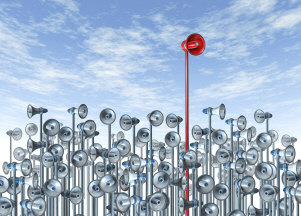 Other products used a traveling show that would go from town to town
incorporating an elaborate play featuring Native Americans. The play showed a
white man suffering from tuberculosis and in it Native Americans came to his
rescue presenting the patent medicine. The man would ingest it and immediately
be cured. These plays used characteristics of the brand, typically these
medicines made claims of ancient healing herbs or Native American secrets, to
embellish the healing properties of the patent medicine. The patent medicine
manufacturers were kings of promotion and suggestion. By using the fear of illness and disease to their favor, manufactures took sales
a step further hoping that eventually people would purchase these products even
when they were healthy. In an attempt to use patent medicines as preventative
medicine these tonics became a part of a daily medical treatment for thousands. Other products used a traveling show that would go from town to town
incorporating an elaborate play featuring Native Americans. The play showed a
white man suffering from tuberculosis and in it Native Americans came to his
rescue presenting the patent medicine. The man would ingest it and immediately
be cured. These plays used characteristics of the brand, typically these
medicines made claims of ancient healing herbs or Native American secrets, to
embellish the healing properties of the patent medicine. The patent medicine
manufacturers were kings of promotion and suggestion. By using the fear of illness and disease to their favor, manufactures took sales
a step further hoping that eventually people would purchase these products even
when they were healthy. In an attempt to use patent medicines as preventative
medicine these tonics became a part of a daily medical treatment for thousands.
 During outbreaks of yellow fever and tuberculosis, patent medicine manufactures
saw huge spikes in sales. Layperson and doctor alike knew very little about
infectious diseases and with the fear of death looming over most of the
population it was almost too easy for the manufacture who used fear as a
powerful sales ally. Unfortunately most of these claims were unfounded and the
so called medicines had little or no medicinal value at all. Other early
advertising techniques like alliteration were also implemented. Makers of these
patent medicines used almost every advertising and promotional tool to prey on
the perceptions of a mostly uneducated population when it comes to illness and
disease. During outbreaks of yellow fever and tuberculosis, patent medicine manufactures
saw huge spikes in sales. Layperson and doctor alike knew very little about
infectious diseases and with the fear of death looming over most of the
population it was almost too easy for the manufacture who used fear as a
powerful sales ally. Unfortunately most of these claims were unfounded and the
so called medicines had little or no medicinal value at all. Other early
advertising techniques like alliteration were also implemented. Makers of these
patent medicines used almost every advertising and promotional tool to prey on
the perceptions of a mostly uneducated population when it comes to illness and
disease.
Unfortunately the general public wasn't the only ones who were ignorant when it
came to infectious diseases. Doctors during this time period knew very little
about the diseases they were attempting to treat and also got caught up in the
zeal of patent medicine's advertisements and claims. There are even accounts of
legal cases that resulted due to physicians using these products to treat the
sick where the patient did not improve and later died.

The promotional and
advertising techniques used by these manufacturers caught both patient and
physician alike in the empty promises of patent medicines.
Patent Medicine Formulas
During the heyday of patent medicines there was an overwhelming attitude that
the worse a medicine tasted the more healing properties it possessed. This
attitude was shared in both the medical and pharmaceutical community. With this
attitude came extremely disgusting tasting formals incorporating a wide range of
ingredients. Often patent medicine makers used a wide variety of botanical
ingredients in their attempt to position themselves as a modern day apothecary
or medicine man.
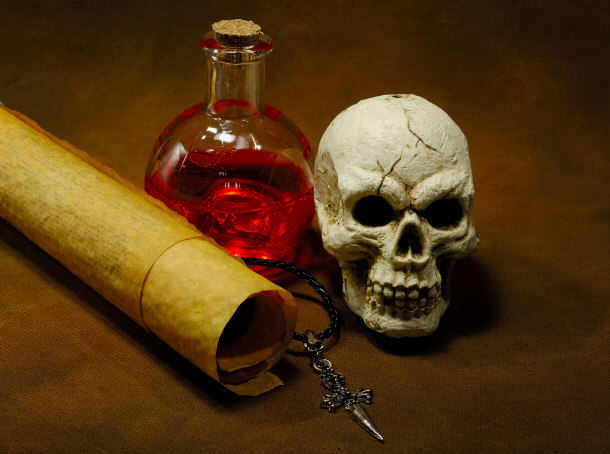
By employing a hint of mysticism, everyday ingredients became
magical in the eyes of the purchaser when often the main ingredients were as
simple as vinegar or creosote. Creosote is a petroleum based product that is
found in railroad ties and acts as a preservation tool. Creosote was the main
ingredient in the earlier mentioned Aromatic Lozenges of Steel and has little or
no medicinal value. The medicinal qualities of the ingredients in patent
medicines were mostly unfounded and their success was largely based on an
ignorant population and extremely strong promotional activities. There were many
patent medicines available but at their core they shared three main ingredients:
suggestion, promotion, and fear.
Addictive and Toxic Ingredients
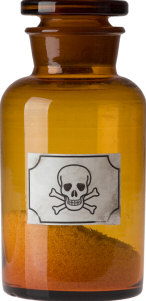 The most popular patent medicines often contained alcohol as well as other
intoxicating substances. By using alcohol discomfort could be temporarily masked
and immediate relief was experienced. There were no healing benefits from patent
medicines. These tonics acted mostly as a symptom masker or duller. The most popular patent medicines often contained alcohol as well as other
intoxicating substances. By using alcohol discomfort could be temporarily masked
and immediate relief was experienced. There were no healing benefits from patent
medicines. These tonics acted mostly as a symptom masker or duller.
Any healing a patient may have been experiencing was mostly attributed to the
psychosomatic properties of the placebo effect mixed with the psychoactive
properties of narcotics like cocaine and opium. Substances like cocaine and
opium drastically alter perception and mood where the tradeoff to the patient is
a temporary feeling of recovery. This false feeling of improvement proved to be
fatal in some cases. There are accounts of cases where extremely sick
individuals took doses of patent medicines, got out of bed, and went out into
the cold. Soon theses very sick patients' conditions worsened where many of them
ended up dead. Not all patients died from using patent medicines and a majority
became strongly chemically addicted to the patent medicines they strongly
believed were making them healthy.
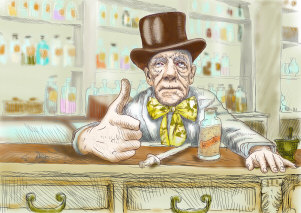 Patients soon became addicted to these powerful drugs and soon craved these
tonics and tinctures even when they were not sick. Patent medicine manufacturers
took this opportunity and began suggesting their products as preventative
medicine. Patients were unknowingly doing great harm to their mind and bodies by
becoming dependent on opium and cocaine all while believing they were taking
care of their health. The selling of a product based on unsubstantiated health
claims that also is potentially damaging is what made patent medicines so
dangerous. Even more frightening is that some of these tinctures contained
mercury which is extremely dangerous to human beings; especially sick human
beings. There is an account of two competing patent medicine manufacturers using
an advertisement claiming that they were now mercury free in comparison to their
competitor whose product still contained mercury. It is hard to believe with
today's labeling standards and Food and Drug Administration regulation that a
company could knowingly sell a product containing this extremely toxic
substance. During the late 1700s and ending with the Pure Food and Drugs Act of
1906, stringent controls as far as labeling and product composition disclosure
did not exist allowing for the proliferation of patent medicines. Patients soon became addicted to these powerful drugs and soon craved these
tonics and tinctures even when they were not sick. Patent medicine manufacturers
took this opportunity and began suggesting their products as preventative
medicine. Patients were unknowingly doing great harm to their mind and bodies by
becoming dependent on opium and cocaine all while believing they were taking
care of their health. The selling of a product based on unsubstantiated health
claims that also is potentially damaging is what made patent medicines so
dangerous. Even more frightening is that some of these tinctures contained
mercury which is extremely dangerous to human beings; especially sick human
beings. There is an account of two competing patent medicine manufacturers using
an advertisement claiming that they were now mercury free in comparison to their
competitor whose product still contained mercury. It is hard to believe with
today's labeling standards and Food and Drug Administration regulation that a
company could knowingly sell a product containing this extremely toxic
substance. During the late 1700s and ending with the Pure Food and Drugs Act of
1906, stringent controls as far as labeling and product composition disclosure
did not exist allowing for the proliferation of patent medicines.
Laissez-Faire Drug Formulation
Patent medicines can owe much of their success to the extremely disorganized,
uneducated, and unregulated medical community of the time. Pharmaceuticals had
little or no governmental controls or regulation as far as labeling and purity
standards. Due to this Laissez-Faire attitude toward public health, research and
development costs associated with bringing a patent medicine to market were
extremely low. Today's barriers to entry associated with modern pharmaceuticals
simply did not exist, and the result was an overwhelming number of tonics and
tinctures saturating the market. Often the formulas for patent medicines were
stumbled on with little chemical or medicinal planning. There were no long term
side effect studies conducted, and too often patients ingested these magical
tinctures with very little concern as to the physiological impact these
medicines made on their bodies.
 Manufactures would experiment by mixing all sorts of ingredients together and
for a lack of better words resulted to winging it as far as formulation
planning. Often the little medical research that was available was extrapolated
when choosing herbs and minerals during product formulation. Typically a patent
medicine manufacture would consult the mineral and herb references they had on
hand and choose herbs based on their believed healing properties. Most of these
conclusions as to the medical viability of the selected herbs were far from
scientific, and common knowledge was used in place of scientific fact. The
manufactures were not completely at fault, scientific research at the time was
limited but it is hard to see what they were doing as altruistically good. Profits were above all else the primary objective and one thing is certain of
patent medicines: they were extremely profitable. Manufactures would experiment by mixing all sorts of ingredients together and
for a lack of better words resulted to winging it as far as formulation
planning. Often the little medical research that was available was extrapolated
when choosing herbs and minerals during product formulation. Typically a patent
medicine manufacture would consult the mineral and herb references they had on
hand and choose herbs based on their believed healing properties. Most of these
conclusions as to the medical viability of the selected herbs were far from
scientific, and common knowledge was used in place of scientific fact. The
manufactures were not completely at fault, scientific research at the time was
limited but it is hard to see what they were doing as altruistically good. Profits were above all else the primary objective and one thing is certain of
patent medicines: they were extremely profitable.
Doctors and Questionable Training
Today physicians worldwide are held to extreme standards and the occupation of
doctor holds a great deal of esteem and respect within the community. This was
not the case during the patent medicine era (beginning in mid 1700s and ending
in 1906). There are accounts of "doctors" allocating their degree through back
channels. One account describes a man marrying a widow whose husband was in fact
a doctor. Upon marriage the man simply changed the name on the widows husband's
diploma and began practicing medicine. Another scary account depicts a man going
down to the county clerk's office and presenting a Chinese napkin to the clerk. He claimed that the napkin was a diploma from a Chinese medical school and
received all the proper documentation he needed and went off to start his
practice Even at the nation's most prestigious medical school, Harvard Medical,
did not require a written exam as late as 1850.
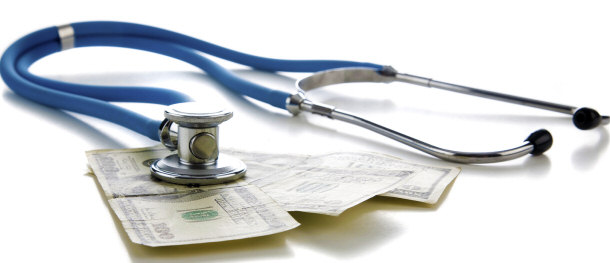
The fear that students would not
possess the written skills necessary to pass one was the primary motivation
behind offering an oral examination process. People were afraid to seek the help
of physicians and this fear was warranted as well as rational. Often when
patients sought the help of physicians they were at death's door and sought
medical counsel as a last resort. People plainly did not seek the help of
physicians on a regular basis like they do today many personal reasons. Behind
each person's reason for avoiding doctors are three contributing factors: fear,
financial cost, and ineffective treatment techniques.
The general populations' fears mostly stemmed from the often grotesque medical
techniques used by physicians during this time. Patent medicine manufacturers
capitalized on the aversion to seeking professional medical help and provided an
alternative that was convenient. Sick people often saw patent medicines as a
much more elegant and safe means for treating their illness than seeking the
assistance of a physician.
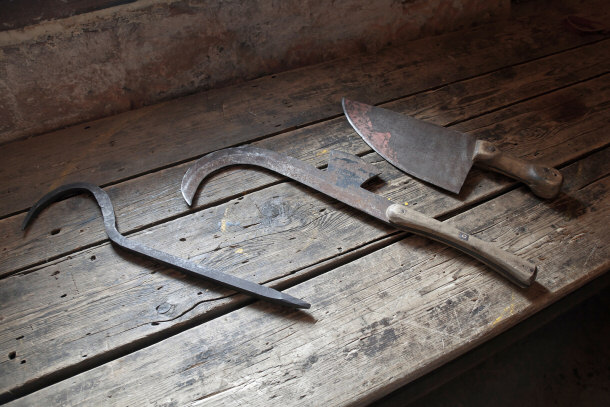
Doctors frequently recommended certain tonics and
tinctures because the manufacturer would cut them a deal or supply them for
little or no charge. The trend of patients seeking the relief of a patent
medicine in place of a physician created a demand for doctors to start coming up
with their own cure-alls and remedies. A doctor's endorsement and use of a
particular patent medicine was extremely profitable. By putting a doctor's name
on a bottle of patent medicine, any healing claims gained some validity and
patients were more likely to purchase the product. Medical devices and their
handbooks served as a surgeon's education and sometimes procedures were made
popular just by the promotion of procedures requiring certain devises.
Doctors as Dangerous as Disease
Practically mid-evil medical techniques like blood-letting and amputation were
two of the most popular medical procedures used by doctors. Prior to the
availability of antibiotics, blood infections would sweep through the body
leaving amputation as the only viable treatment. Blood-letting is an ancient
technique that was first used by native peoples all over the world and modernly
was executed by attaching leeches to the patient during the procedure.
Hirudotherapy - Or Blood-letting Facilitated with Live
Leeches
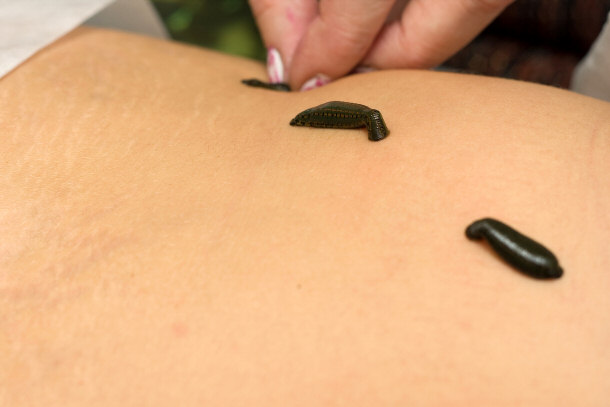
The
belief was that by draining a patient of upwards of 80 percent of their blood,
any diseases would be removed with the discarded blood and allow for healthy
blood to be produced in its place. Many patients passed out from the loss of
blood and it is unclear if any patients actually recovered or benefited from the
procedure. Many patients died shortly after the procedure was executed either as
a result of the loss of blood or from the illness that had led them to a
physician in the first place.
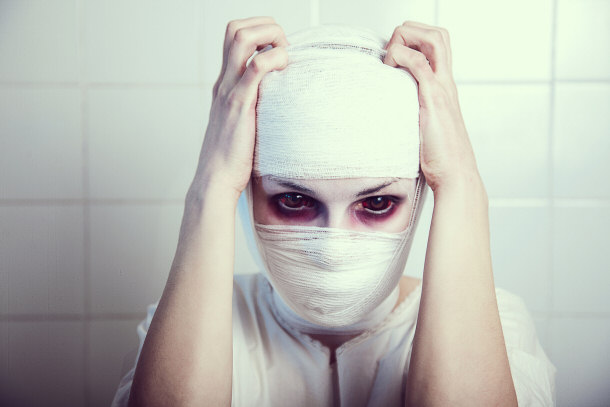
The medical environment has drastically changed since the end of the patent
medicine era but there are still themes that remain. Doctors are not in the
business of curing disease but rather providing solutions to managing the
symptoms of sick patients. If there were cures for diseases like AIDS and common
cancers would pharmaceutical manufacturers be inclined to share them with the
public? Unfortunately the short answer is no, and from a business stand point
providing a cure to diseases that require long-term care would be financial
suicide. Chemotherapy and antiviral treatments are profitable in the long run
and rely on repeat business similar to patent medicines. Manufacturers relied on
patients coming back time and time again to make purchases and likewise
pharmaceutical companies are most profitable when they require patients to take
them for the rest of their lives. The best medicine for everyone is preventive
medicine in the form of nutrition and regular testing for cancers. Taking care
of our bodies by eating healthier foods, restricting caloric intake, and getting
preventive exams are our best chance of maintaining a healthy lifestyle. Medicine is never the answer and unfortunately by the time a patient begins a
medication routine the disease has progressed to a point that medication is
mandatory. Often if steps were taken earlier on the patient could recover
without medication or at least result to taking them for a limited time period. Patent medicines have shown us the ugly side of medicine and set a precedent
of full disclosure which is
how medicines are marketed and sold today. Thanks to the advances in medical
training and technology patent medicines are a thing of the past. Do you have
any experiences similar to patent medicines in that you were advised to take a
tonic or natural remedy? What was it and did it help you?
Works Cited:
"McSweeney's Internet Tendency: The State of Publishing: Literacy Rates."
McSweeney's Internet Tendency. N.p., n.d. Web. 05 Feb. 2013.
Young, James Harvey. The Toadstool Millionaires. Princeton (New Jersey):
Princeton UP, 1961. Print.
Medicine & Treatments
Top Lists:
Top 15 Hangover Cures That Actually Work
Top 15 Unusual Ways To Treat Diseases
Informational:
Computerized Physician Order Entry and ePrescribing
Health Data and Importance of Digitization
Nursing Information Systems – Vendor Market Analysis
Telehealth - Healthcare Informatic's Golden Egg
EHR, EMR, PHR – The Digital Future of Health Data
Bloodless Surgery – An Effective Alternative to Blood Transfusion
Medicines That Have Changed the World
The Process of Female Egg Donation
How Chemotherapy Treats Cancer
Thighplasty: Is a Leg Lift Procedure Right for You?
Treating Acne with Laser Therapy: Can it Benefit You?
Using Tanning Beds to Treat Vitamin D Deficiency
Choosing Birth Control
Social History of Patent Medicines
Biology
An Introduction to the Cells of Organisms
Cardiovascular System and Energy Systems |